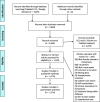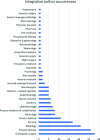Chiropractic case reports: a review and bibliometric analysis
- PMID: 33910610
- PMCID: PMC8080364
- DOI: 10.1186/s12998-021-00374-5
Chiropractic case reports: a review and bibliometric analysis
Abstract
Objective: To determine publication trends, gaps, and predictors of citation of chiropractic case reports (CRs).
Methods: A bibliometric review was conducted by searching PubMed, Index to Chiropractic Literature (ICL), and Google Scholar to identify PubMed-indexed CRs, which were screened according to selection criteria. Case reports were categorized by International Classification of Disease (ICD-10) code, patient age, topic describing case management or adverse effects of care, focus being spinal or non-spinal, journal type, integrative authorship, title metrics, and citation metrics. Binary logistic regression was used to identify independent predictors of citations per year and total citations greater than the median values.
Results: The search identified 1176 chiropractic CRs meeting selection criteria. There was an increasing trend of CRs having a case management topic, non-spinal focus, non-chiropractic journal, neuromusculoskeletal-focus, diagnosis of vascular pathology, and a decreasing trend of adverse effect vascular pathology CRs. Independent predictors of greater total citations (or citation rate) included ICD-10 categories of perinatal conditions, infections, "case" in title, case management topic, and physical therapy, integrative, and dental journal type. Predictors of fewer citations included diseases of the blood, neoplasms, other findings not elsewhere classified, a title > 11 words, and multidisciplinary authorship. ICD-10 categories describing non-musculoskeletal diseases and special populations such as pediatrics, pregnancy, and perinatal conditions had few CRs.
Conclusion: Chiropractic CRs are diversifying from spine-related topics. Chiropractors are encouraged to publish objective, structured CRs within defined research gaps. Published CRs can inform the design of future research studies with a higher level of clinical relevance and evidence.
Keywords: Bibliometrics; Case reports; Chiropractic; Information science; Literature review; Musculoskeletal diseases; Spine.
Conflict of interest statement
The authors declare that they have no competing interests.
Figures









Similar articles
-
A descriptive analysis and checklist critique of the articles in the Journal of Clinical Chiropractic Pediatrics, 1996 to 2007.J Manipulative Physiol Ther. 2009 Oct;32(8):654-9. doi: 10.1016/j.jmpt.2009.08.022. J Manipulative Physiol Ther. 2009. PMID: 19836602
-
Bibliometric Analysis of Erectile Dysfunction Publications in Urology and Sexual Medicine Journals.J Sex Med. 2018 Oct;15(10):1426-1433. doi: 10.1016/j.jsxm.2018.08.004. Epub 2018 Sep 12. J Sex Med. 2018. PMID: 30219665
-
Bibliometric Analysis of Palliative Care-Related Publication Trends During 2001 to 2016.Am J Hosp Palliat Care. 2018 Oct;35(10):1280-1286. doi: 10.1177/1049909118773751. Epub 2018 May 8. Am J Hosp Palliat Care. 2018. PMID: 29739246
-
A bibliometric study on trends in chiropractic research from 1920 to 2023.Complement Ther Med. 2024 Jun;82:103038. doi: 10.1016/j.ctim.2024.103038. Epub 2024 Apr 4. Complement Ther Med. 2024. PMID: 38582375 Review.
-
Chiropractic treatment of lower extremity conditions: a literature review.J Manipulative Physiol Ther. 2006 Oct;29(8):658-71. doi: 10.1016/j.jmpt.2006.08.004. J Manipulative Physiol Ther. 2006. PMID: 17045100 Review.
Cited by
-
Concurrent Spinal and Intracranial Subdural Hematomas as a Cause of Near-Fatal Low Back Pain in the Chiropractic Office: A Case Report.Cureus. 2022 Nov 26;14(11):e31900. doi: 10.7759/cureus.31900. eCollection 2022 Nov. Cureus. 2022. PMID: 36579221 Free PMC article.
-
Pancoast Tumor Presenting as Neck Pain in the Chiropractic Office: A Case Report and Literature Review.Am J Case Rep. 2022 Jul 7;23:e937052. doi: 10.12659/AJCR.937052. Am J Case Rep. 2022. PMID: 35797264 Free PMC article. Review.
-
Spondylodiscitis Presenting to a Chiropractor: A Case Report and Literature Review.Cureus. 2023 Feb 26;15(2):e35491. doi: 10.7759/cureus.35491. eCollection 2023 Feb. Cureus. 2023. PMID: 36860824 Free PMC article.
-
Conservative Management of Cervicogenic Dizziness Associated With Upper Cervical Instability and Postural Orthostatic Tachycardia Syndrome: A Case Report.Cureus. 2024 Oct 31;16(10):e72765. doi: 10.7759/cureus.72765. eCollection 2024 Oct. Cureus. 2024. PMID: 39618563 Free PMC article.
-
Symptoms of Patients With Vertebral Artery Dissection Presenting to Chiropractors: A Systematic Review and Meta-Analysis.Cureus. 2023 Dec 29;15(12):e51297. doi: 10.7759/cureus.51297. eCollection 2023 Dec. Cureus. 2023. PMID: 38283533 Free PMC article. Review.
References
-
- Keating JC, Jr, Caldwell S, Nguyen H, Saljooghi S, Smith B. A descriptive analysis of the Journal of manipulative and physiological therapeutics, 1989-1996. J Manip Physiol Ther. 1998;21(8):539–552. - PubMed
-
- Keating J, Jr, Larson K, Stephens M, Mick T. Journal of Manipulative & Physiological Therapeutics: a bibliographic analysis. J Manip Physiol Ther. 1989;12:15–20. - PubMed
Publication types
MeSH terms
LinkOut - more resources
Full Text Sources
Other Literature Sources
Medical

